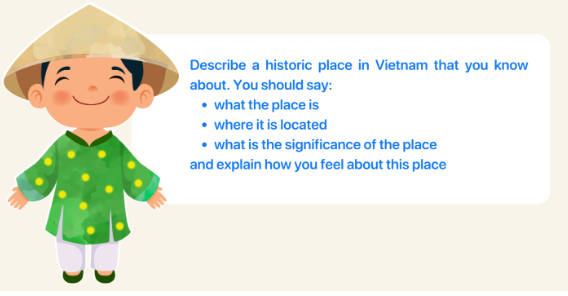Describe a historical place in Vietnam | Bài mẫu Speaking Part 2, 3
Bài mẫu IELTS Speaking Part 2 chủ đề Describe a historical place in Vietnam
1. Mẫu 1

Bài mẫu:
In Hanoi, there’s a place that I absolutely love to talk about whenever history is mentioned. It’s the Long Bien bridge, built over the Red River nearly two centuries ago by the French, who colonized my country during that period.
It’s one of the links between the central part of Hanoi and the east side of the city. Because the bridge is so old, it has been in place to witness many crucial events in Hanoi’s history. Long Bien had been fixed many times when it was bombed during the war, and afterward, when we constructed more modern bridges for dense motor traffic, this bridge became for cyclists and pedestrians only.
Nowadays, the Long Bien is seldom taken by commuters, but it doesn’t feel any less important. It actually has a role in adorning the landscape of Hanoi since it is so photogenic. The scenery on the Red River becomes livelier with it, so you can understand why some consider Long Bien to be Hanoi’s signature landmark.
For me, this bridge is also a part of my life because it’s my favorite spot to cycle. I can’t remember since when I’ve felt an attachment to this place. The Long Bien is certainly ancient by today’s standards, which is why I believe the government should spend some money maintaining it. But at the same time, the work should be done in a way that allows the bridge to retain its structural beauty.
Tư vựng:
- Colonize (v.): đô hộ thực dân
- Witness (v.): chứng kiến
- Dense (adj.): dày đặc
- Pedestrian (n.): người đi bộ
- Seldom (adv.): hiếm khi
- Adorn (v.): tô điểm
- Landscape/scenery (n.): phong cảnh
- Photogenic (adj.): ăn ảnh
- Lively (adj.): sống động
- Landmark (n.): địa danh
- Attachment (n.): sự gắn bó
- Ancient (adj.): cổ kính
- By today’s standards: theo tiêu chuẩn ngày nay
- Retain (v.): giữ được
- Structural beauty (n.): nét đẹp kiến trúc
2. Mẫu 2
I would like to talk about The Lost City of the Incas, Machu Picchu, which is one of new seven wonders of the world. It is located in the Cusco region of Peru in South America. It is composed of the remaining ruins of a city that lies at the top of a mountain, which is only accessible by trekking through the mountains for four days or by taking a train. It used to be an important cultural center for the Inca civilization that had to be abandoned when the Spanish invaded the region. It’s an astonishing piece of architecture built on a 400 feet cliff.
The rocks used to construct the walls of the city were extremely heavy and they were pushed up the mountain or chiseled from the side of the mountain itself by the Incas. Another interesting fact about the construction is the technique used involved making perfectly shaped stones so that no mortar would be needed to fit them together. The city is made up of over 150 buildings which include temples, sanctuaries and housing.
There are also over 100 flights of stairs, most of which are carved from a single slab of stone. It’s very hard to describe the majesty of the place, there is just something so inspiring about the mystery that surrounds it and how it was abandoned. Unfortunately, there are concerns over the growing number of tourists which have led to limitations on how many people can enter the site so that it can be better preserved for future generations.
|
Vocabulary
|
Phonetic
|
Meaning
|
|
composed
|
/kəmˈpəʊzd/
|
được tạo thành từ
|
|
ruin
|
/ˈruːɪn/
|
đống đổ nát
|
|
accessible
|
/əkˈsɛsɪb(ə)l/
|
có thể tiếp cận được
|
|
civilization
|
/ˌsɪvɪlʌɪˈzeɪʃ(ə)n/
|
nền văn minh
|
|
abandoned
|
/əˈband(ə)nd/
|
bỏ hoang
|
|
invade
|
/ɪnˈveɪd/
|
xâm lược
|
|
architecture
|
/ˈɑːkɪtɛktʃə/
|
kiến trúc
|
|
chiseled
|
/ˈtʃɪzəld/
|
được đẽo từ cái đục đá
|
|
mortar
|
/ˈmɔːtə/
|
cối
|
|
sanctuary
|
/ˈsaŋ(k)tjʊəri/
|
nơi ẩn náu
|
|
majesty
|
/ˈmadʒɪsti/
|
sự nghiêm trang
|
|
limitation
|
/lɪmɪˈteɪʃ(ə)n/
|
giới hạn
|
|
preserve
|
/prɪˈzəːv/
|
bảo tồn
|
3. Mẫu 3
Ok, so I’m going to talk about one of the most famous and most recognisable landmarks in the world, and that is the Statue of Liberty, located in New York City. I think just about everybody knows this statue and associates it with freedom, or America, or New York City, or something like that. I think it's actually located on its own island, called Liberty Island, which is not too far from Manhattan where all the skyscrapers are in New York. I think to get to the monument, you have to catch a ferry. And I think a lot of people go there each year, as it's one of the most famous tourist attractions in New York City. As far as I know, the monument was given to America as a gift by the French, and it became a symbol of freedom in America and a welcome to immigrants arriving by sea. And I think it is made of copper, so it must be extremely heavy because I think it is about 30 to 40 metres tall. So, to describe the monument, I would say that it is a statue of a woman, a Roman liberty goddess to be more specific, dressed in a robe, wearing a crown, holding a flame torch in one hand above her head, and a book with some dates inscribed on its open pages. I’m not sure what the dates signify though. Another interesting fact about this statue is that it used to be a kind of reddish-brown colour, like the colour of copper, but over time, the metal had some chemical reactions with the surrounding air and water and it has turned green now. Quite fascinating I think.
Anyway, so I think the main reasons why I like this monument is because it actually has some interesting history, and it seems to have a lot of significance to American people and their sense of freedom. It also looks pretty cool, and if I ever went to New York City I would definitely go to this monument and walk up inside to the lookout in the statue’s crown. The view would be amazing I am sure.
Phân tích từ vựng
- recognisable landmark: địa danh dễ nhận biết
- (to) associate: liên kết
- (to) catch a ferry: bắt một chuyện phà
- tourist attractions: điểm thu hút khách du lịch
- a symbol of freedom: biểu tượng của tự do
- immigrant: dân nhập cư
- liberty: sự tự do
- Inscribe (v): ghi/khắc (chữ)
- Signify (v): biểu thị
- Significance (n): Ý nghĩa/ tầm quan trọng
- a sense of freedom: ý thức về sự tự do
- the lookout (n): đài quan sát
Câu trả lời mẫu IELTS Speaking Part 3: Historic Place
1. How do people in your country feel about protecting historic buildings?
I think the general attitude toward protecting historic buildings is lukewarm at best. Many people have other more pressing concerns than preserving this sort of building. However, I believe that the government is also doing its best to keep these structures intact when considering urban development projects.
-
-
- General attitude (n.): thái độ chung
- Lukewarm (adj.): lãnh đạm
- Pressing (adj.): cấp bách
- Preserve (v.): bảo tồn
- Intact (adj.): nguyên vẹn
- Urban development (n.): phát triển đô thị
2. Do you think an area can benefit from having an interesting historic place locally? In what way?
Any area could immediately have something to gain from having a local historic spot. It would be a great destination for both domestic and international tourists, and therefore, it would provide an additional source of income for local inhabitants. Furthermore, the existence of a famous ancient structure could serve as a reminder for people to remember their own history.
-
-
- Source of income (n.): nguồn thu
- Existence (n.): sự tồn tại
- Reminder (n.): lời nhắc nhở
3. What do you think will happen to historic places or buildings in the future? Why?
In my opinion, those kinds of buildings will still be maintained and preserved for their historical significance. Also, with the public opinion tending to shy away from modern architecture these days, there will definitely be a demand for municipal governments to protect ancient buildings, and historic architecture on the whole.
- Shy away from sth (v.): không ưa điều gì đó
- Municipal government (n.): chính quyền thành phố
Xem thêm các tài liệu Tiếng Anh hay, chi tiết khác:
TOP Việc làm "HOT" dành cho sinh viên:




